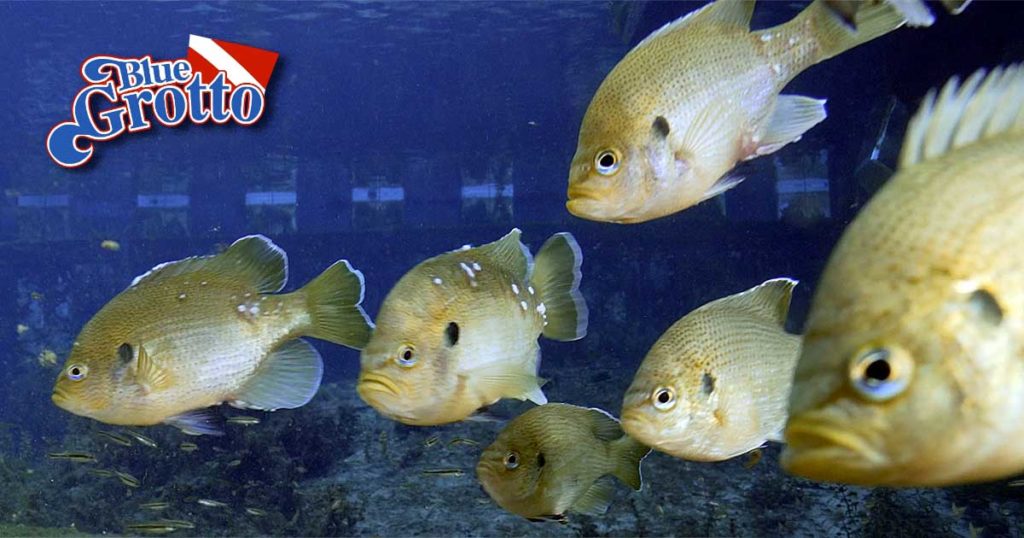Among the many reasons divers enjoy coming to the Grotto is the abundance of aquatic life. Miss Virgil is, of course, the center of attention. But you can’t overlook the hundreds of fish that congregate over the training platforms.
There are actually several species of fish that inhabit Blue Grotto. But the most prevalent, by far, are the bluegill. Bluegill behavior can vary by region. Ours, however, appear to be very comfortable around divers. They can be attracted by video lights and the sound made by rubbing your thumb and forefinger together.
But where did they come from?
This is the question few people think to ask. Some things we know with a high degree of certainty.
- They didn’t walk here or slither in on their bellies like snakes.
- They didn’t drive here in cars, trucks or SUVs.
- They didn’t swim here through miles of pitch-black underground passageways.
- They didn’t just materialize spontaneously.
We have heard several possible explanations. Some seem possible; others are just plain ridiculous. Among the most plausible explanations, however, is what some call The Egg Bomb Theory.
The egg bombers
If you are squeamish, you may want to stop reading now. Otherwise:
- There are species of birds that eat fish eggs.
- Sometimes these eggs will pass through the birds undigested. According to an article on the Audubon Society website, research shows this happens 0.2 percent of the time and is responsible for fish species appearing in bodies of water they would not normally inhabit.
- If this happens while the bird is overflying the Grotto, we get egg bombed.
Obviously, this is a very rare occurrence. Bear in mind, however, that the Grotto has existed in its present form for thousands of years. Given the millennia, enough time has passed for the egg bombers to have established a healthy bluegill population. In fact, today’s bluegills are likely the descendants of hundreds of generations before them.
Maintaining a healthy population
In case you were wondering, No, we don’t feed the fish. Nor do we stock the Grotto with non-native species. In terms of fish, what you see is largely natural. Several factors contribute to this.
- Thanks to its shape, the Grotto receives plenty of sunlight.
- The sunlight, combined with the presence of nitrates in the water, leads to the growth of algae.
- Algae appears to be the primary food source for the bluegills and other fish. In fact, without them, features like the training platforms might be overgrown with algae.
- The size of the bluegill population is limited by the available food source. In this respect, it is self-regulating.
We didn’t plan this. It just worked out this way.
How does the Grotto compare?
You see bluegills in nearly every North Florida spring and sinkhole. Sometimes, there is an abundance of them. At other times, they are comparatively rare. For example:
- At Wes Skiles Peacock Springs State Park, you will see almost no fish at Peacock I or Orange Grove Sink. So what makes them different?
- Both Peacock and Orange Grove are home to a surprisingly large alligator population. You won’t see them; they avoid people.
- Fish, however, are a primary food source for the gators.
Blue Grotto, on the other hand, is gator-free. Thus, our bluegills have no natural predators.
Other facts worth noting
- If you swim up quietly to the shallowest platform at the Grotto and hold yourself so that your eyes are level with the platform, you will usually see that it is a spawning ground for hundreds of baby minnows.
- Bluegills don’t live forever. Yet, despite this, you are unlikely to see any dead fish in the Grotto. We know that Miss Virgil and her little buddy Turbo can be carnivorous. We assume that they act as a cleanup squad. (Hey, turtles need protein, too.)
And, finally, a word from Douglas Addams
The title of one of Douglas Addams’ Hitchhiker’s Guide novels was So Long, and Thanks for all the Fish. That pretty much sums up our feelings. We didn’t put them there, but we are glad they are.


